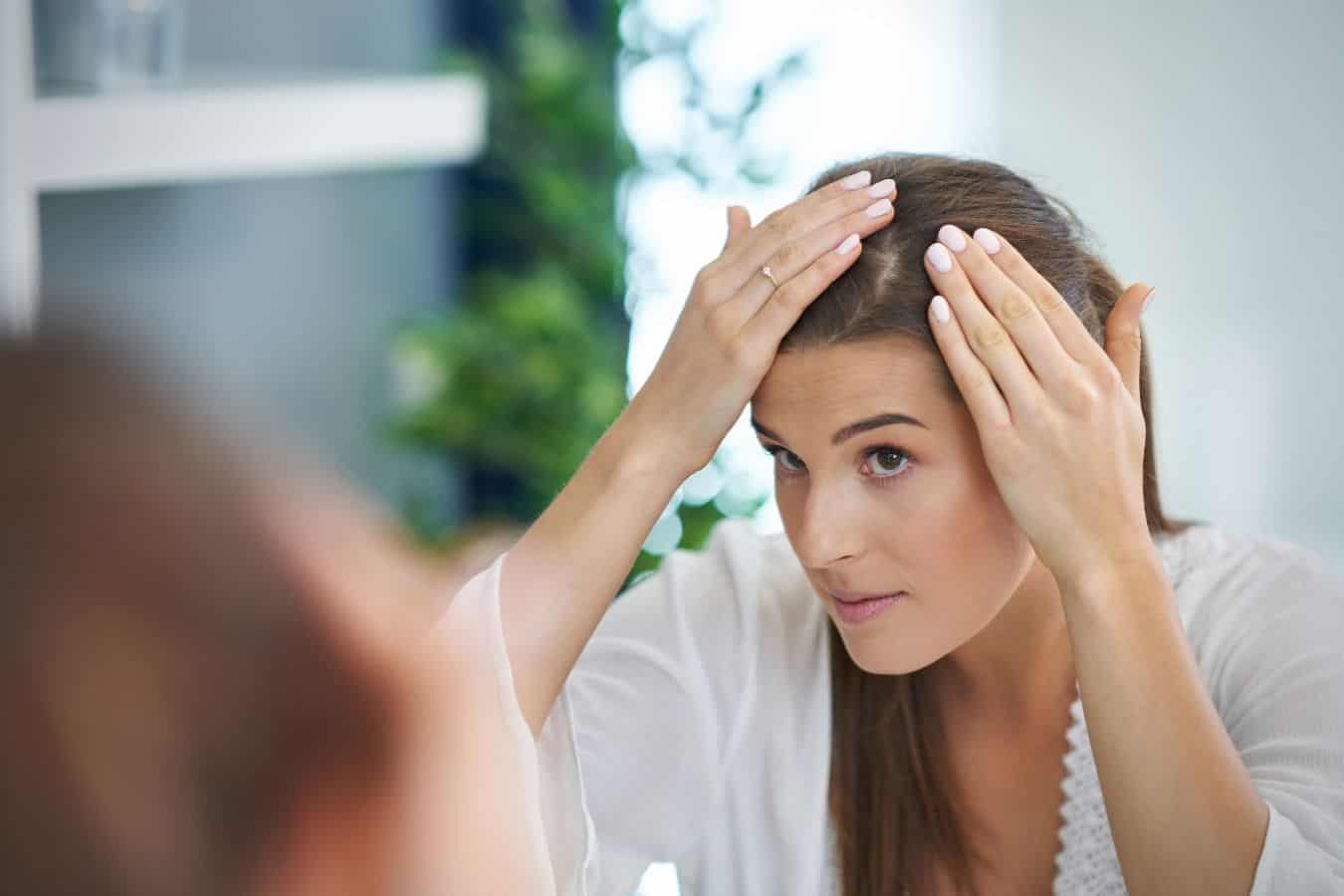Healthy hair begins with a healthy scalp. In this article, we’re going to explain the most effective ways to increase blood flow to the scalp.

Why Is Scalp Care So Important
Scalp care is overlooked at times, but it’s an important part of the overall health of your hair. In fact, many common hair issues begin with poor scalp health.
The scalp is responsible for oil regulation and encouraging new hair growth, so it’s vital that the scalp receives extra care that goes beyond just shampoo and conditioner.
Good scalp care ensures that the hair remains in healthy, strong condition, with good elasticity. This protects against dryness, frizz, split ends, breakage, and hair loss.
What Happens If There Isn’t Enough Blood Flow To The Scalp
Poor blood circulation can have a detrimental effect on the hair follicles because they will not be receiving the nutrients and oxygen that they need.
This will leave the follicles weaker and smaller, resulting in brittle strands and even hair loss.
It’s likely that without adequate blood flow to the scalp, the hair will remain in poor condition.
Signs Your Scalp Needs Additional Care
There are some tell-tale signs that your scalp is in need of some extra care, these include:
- Dull hair
- Lack of volume
- Hair becomes finer
- Strands lose elasticity
- Hair breaks off easily
- Stunted hair growth
- Hair loss
You should never ignore any of these symptoms because your hair is often a good indication of your health.
If you’re experiencing hair loss or scalp issues, it’s time to look into what could be causing it and how you can begin treating it.
10 Ways To Increase Blood Flow To Your Scalp

There are many effective ways to increase blood flow to your scalp and reverse some of the symptoms you may be experiencing.
You may need to apply more than one method and repeat them for a few months before you see a difference.
Scalp Massage
Massaging the scalp is a highly effective way to stimulate blood circulation and relieve a dry, itchy scalp.
It also helps your body and your scalp to relax and loosen, which can further help with blood flow to the scalp. Doing this regularly can help to reverse weakened follicles and supply adequate nutrients to the scalp.
This will result in healthier, stronger, and fuller hair.
To give yourself a scalp massage all you need to do is:
- Choose a pure oil like extra virgin olive oil or coconut oil and heat it up a little bit
- Make sure hair is damp before applying
- Start applying a small amount of oil to the scalp (1 – 6 tablespoons, depending on thickness and texture)
- Using your fingertips, not your nails, apply a generous amount of pressure and massage in circular motions
- Start from the front of the scalp and continue to massage the sides and the back, making sure to apply the right amount of pressure throughout
- Do this for at least 5 minutes
- Optional: leave the oil in for a further 15 – 30 minutes to provide deeper hydration to the scalp
- Rinse it out
Use A Clarifying Shampoo Or Rinse
Product build-up, excess oils, and residue can lead to the hair follicles becoming clogged.
When this happens, it makes it harder to receive adequate blood flow, which can result in them shrinking and becoming weaker.
Not only can this weaken the hair strands but it puts you at higher risk of a scalp infection.
For this reason, it’s important that you clarify the week at least once a month to remove any build-up.
Some people who regularly use different hair products like creams, sprays, and gels, may need to clarify once a week or once every two weeks.
You can use a clarifying shampoo, but keep in mind that some of these can be drying on the hair.
Check the label to ensure that it contains mostly natural ingredients before applying, especially if you have a dry or sensitive scalp.
Alternatively, you can do an apple cider vinegar rinse. It’s completely natural and is usually less drying on the hair and scalp.
- Mix approximately half a cup of ACV with 1 cup of water in a bottle
- Rinse the hair with water
- Pour the ACV rinse over your scalp and massage it in for 3 -5 minutes
- Rinse with cool water again
Also Read: How To Use Baobab Oil For Hair Growth (3 Ways)
Brush Your Hair
Brushing your hair should be done every day to avoid hair loss. The bristles on the brush can help to massage the scalp and increase blood flow.
It also helps to prevent the pores from becoming clogged by removing dead skin cells and old hair.
While it’s not necessary to brush your hair 100 times a day, it’s still important to do it daily.
Detangle your hair with your fingers or a wide-tooth comb first. This will prevent tangles, knots, and breakage.
If you have thick, textured, or delicate hair, always start brushing from the ends of your hair and make your way to the scalp.
You should avoid pressing too hard on the scalp as this can damage the scalp and leave you open to infection.
Apply just enough pressure to remove impurities and stimulate blood flow. A few strokes through the hair should be enough.
Use Essential Oils
Some essential oils can help to increase blood flow to the scalp and improve hair condition.
Essential oils like tea tree also have antibacterial, anti-fungal, and antimicrobial properties that can help to relieve common issues like dandruff and an itchy scalp.
This can help to relax the scalp and unclog the pores, resulting in better circulation.
- Dilute the essential oil with a carrier oil of your choice. Typically, 3 – 6 drops of essential oil should be enough
- Apply the oil to damp hair and massage from the roots
- In circular motions, gently press and massage around the scalp to lift residue and stimulate blood flow
- Rub the oil throughout the hair to provide hydration
- After 3 – 5 minutes, rinse it out and leave the hair to dry
This can be done once a week or once a fortnight, depending on the condition of your hair and scalp.
Use Natural Hair Products
Keeping your hair clean and free of product build-up and excess grease is key to maintaining a healthy scalp.
Unfortunately, there are many hair products that contain chemicals and harsh ingredients that can dry out the hair or cause scalp irritation.
The more products you use on your hair, the more likely they are going to build upon the scalp and clog the pores.
Switch to using products with only natural ingredients as the more gentle formula is, the less likely it will be to damage or irritate the scalp.
Wash Your Hair With Cold Water
Many people wash their hair with hot water but this can be drying and damaging on the scalp.
Rinsing with lukewarm or cool water while shampooing or conditioning your hair is the best way to cleanse your hair and scalp while protecting it against damage.
After you have conditioned your scalp, it’s recommended that you blast the hair and scalp with cold water to seal the cuticles and help to increase blood flow.
Cold water can also help to reduce frizz and give hair a natural shine.
Change Your Diet
Diet can have a huge role in the health of your hair. In fact, there are some natural foods that are known to increase blood circulation. Some of these include:
- Onions
- Pomegranate
- Cinnamon
- Celery
- Garlic
- Raw seeds like chia, pumpkin and flax
- Fatty fish
- Oats
- Green vegetables
- Tomatoes
- Turmeric
Incorporating some of these foods, along with other natural foods, into your diet can help to lower inflammation in the body, reduce stress, and promote circulation throughout the body.
Increase Your Water Intake
Water plays a huge role in the body and is responsible for transporting oxygen to cells and tissues.
When you become dehydrated, you may notice that your hair is rougher, drier, or dull. This is because the hair needs sufficient water to grow and thrive.
Making sure you are drinking enough water throughout the day (around 8 – 10 glasses) will ensure that there is enough blow flow to the scalp.
You can remind yourself by settling alarms on your phone, leaving notes on your desk, or using a smartphone app that sends out reminders.
Inverted Position
A simple way to increase blood flow to the scalp is to try the inversion method. All you need to do is lie down on your bed and hang your head over the edge.
You will want to remain in that position until you feel a sensation of blood flowing to your head. It’s important to not be in this position for too long as it can make you dizzy and potentially ill.
5 – 10 minutes should be enough time to reap the benefits. This method alone will not improve the overall health of your hair, so it should be used in combination with a few other methods.
Do More Exercise
Exercise releases endorphins which can help to relieve anxiety and stress. This creates a balance in the body, resulting in better blood circulation throughout.
Exercise also helps with weight management, which can also help to increase blood flow. In fact, obesity has been linked to health conditions that are related to hair loss. All kinds of exercises are good for the body, some of these include jogging, biking, and swimming.
Certain exercises like yoga can have a very positive impact on the body and mind by relieving chronic stress and tension and allowing for better circulation. Some of the poses you can try are:
- Downward dog
- Wind-relieving pose
- Diamond pose
- Shoulder stand
- Inversion
- Legs up on the wall pose
It’s important to minimize stress in your life because chronic stress can cause the hair follicles to go into a ‘resting’ phase which can lead to hair thinning and hair loss.
Disclaimer: This site is not intended to provide professional or medical advice. All of the content on LovedByCurls.com is for informational purposes only. All advice should be followed at your own discretion. Ingredients may change at any time so always check the product label before using. Check our full disclaimer policy here.
